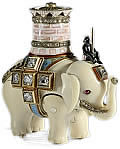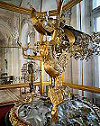Fabergé Eggs with Automatons
Automaton "An automaton is any of various mechanical objects that are relatively self-operating after they have been set in motion. The word Automaton, plural automatons or automata, is derived from the Greek αúτόματος, automatos, "acting of one’s own will" and is often used to describe non-electronic moving machines, especially those that have been made to resemble human or animal actions, such as the jacks on old public striking clocks, or the cuckoo and any other animated figures on a cuckoo clock". (Wikipedia) Karl Fabergé and Automata For over twenty years Karl Fabergé Fabergé Eggs with Automata There are six Imperial Eggs that have, or had, an automaton, and three known Eggs of "Imperial Quality". These nine Eggs with automata are:
Remarkable is that the above six Imperial Eggs were all made for Tsarina Maria Feodorovna.
There is a train in the 1900 Trans-Siberian Egg, made for Tsarina Alexandra Feodorovna, but as the movement of this train does not "resemble a human or animal action" it is strictly speaking not an automaton. The 1898 Lilies of the Valley Egg has a mechanism to move the little portraits, but this Egg for Tsarina Alexandra, is not an automaton.
The mechanism of the Rothschild Fabergé Clock Egg is extensively documented in the Christie's sales catalogue, November 25, 2007.  The mechanism of the Rothschild Clock Egg Courtesy Christie's There are more automatons made by Fabergé; a beautiful example is a mechanical silver Elephant in the Collection of Her Majesty Queen Elizabeth II, Great Britain. This Elephant was presented to King George V. On the Website of the Royal Collection you can see this automaton in a little movie! For automatons filmed while moving, click here!
Page updated: January 7, 2019 awp February 2008
|



